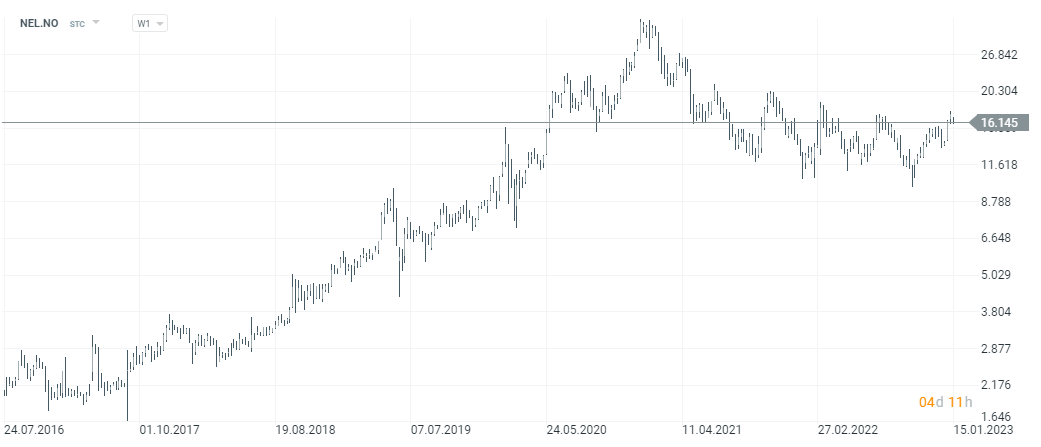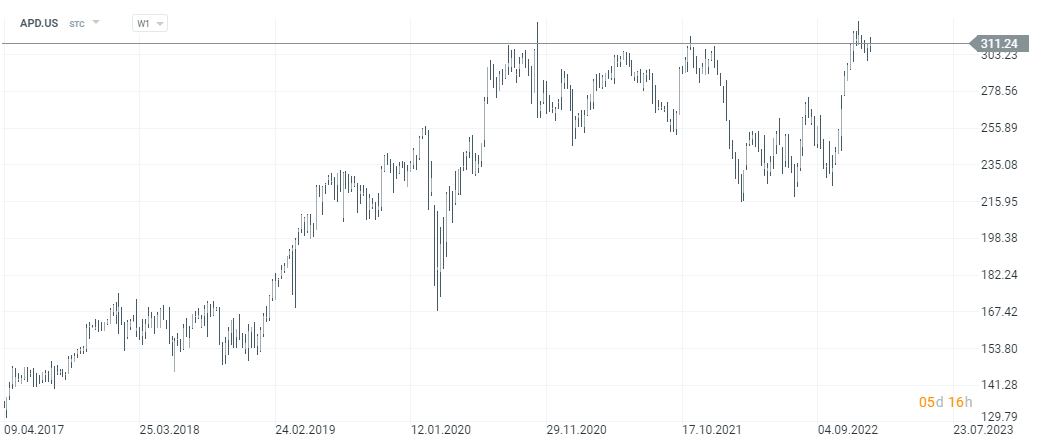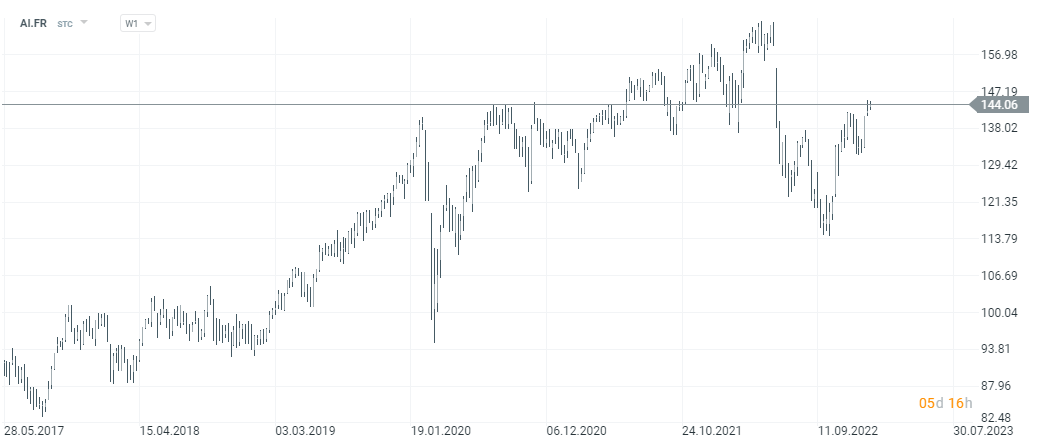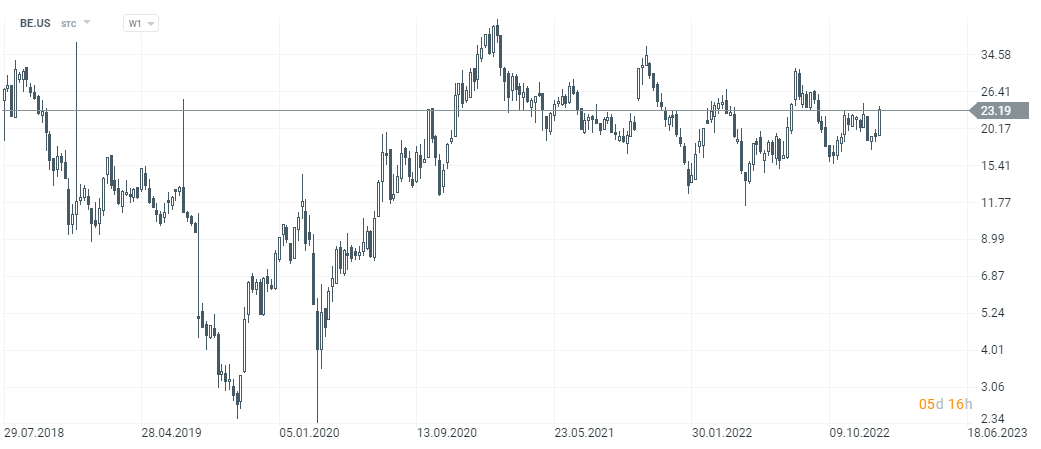How to invest in hydrogen? Hydrogen stocks and ETFs [Guide]
Moving away from hydrocarbons and coal causes scientists to try to develop cleaner energy sources that will ensure the energy transformation of the global economy. In recent years, RES (Renewable Energy Sources) have been in the lead. Wind farms and solar panels were to ensure that there would be no need to use hard coal, lignite or natural gas. The problem with generating this energy is that it is not possible to store it. As a result, RES produces too much energy during favorable conditions (e.g. strong wind, high insolation). Therefore, it is energy that does not ensure stable energy production. Another solution is nuclear energy, which provides clean energy, but the side effect is the production of radioactive waste. For now, thermonuclear fusion is the tune of the future. Another idea is the use of hydrogen as a clean fuel used to produce electricity. In today's text, we will check whether it is possible to invest in hydrogen on stock exchanges. We invite you to read!
How is hydrogen produced?
It is estimated that about 30% of the sun's mass is hydrogen. This element is also there 3rd most common element on earth. It is therefore one of the potential, easily accessible sources of energy for humanity. As far back as the 60s, hydrogen was used as fuel for the Apollo space rockets. Previously, hydrogen was used as one of the gases used to fill airships. However, the Hindenburg disaster stopped the development of airships. She also pinned hydrogen a dangerous gas label.
Hydrogen is not available on earth in the form of natural gas or Petroleum. There are no large deposits of hydrogen that can be "mined" in a similar way to natural gas. Hydrogen, although it is very common in the universe, must be produced because it reacts very easily with other elements. The most popular methods of obtaining hydrogen include:
- Natural gas reforming,
- Water electrolysis.
Currently, however hydrogen is most often produced using the so-called reforming natural gas. The element obtained is the so-called "gray hydrogen". However, reforming natural gas is not "eco". Greenhouse gases are produced in this process.
What does the reforming process look like?
The steam is heated to a temperature of 750 - 950 degrees Celsius. The result is syngas. The efficiency of steam reforming is about 75%. At the same time, it is worth noting that to produce 1 kilogram of hydrogen, 9-12 kg of carbon dioxide are emitted. By means of steam reforming, synthesis gases are obtained, which are used to produce methanol, ammonia and hydrogen. Syngas is a mixture of carbon monoxide, hydrogen and carbon dioxide. This production method is used in petrochemical, food, nitrogen and metallurgical enterprises.
The second method is the electrolysis of water. This is a more "green" way to obtain hydrogen. However, due to costs and problems with production scaling, it is not as popular a method as gas reforming. Currently, about 4% of the hydrogen obtained comes from the electrolysis of water. Out of this, only 25% of production takes place with the use of Renewable Energy Sources. Water electrolysis is a process that breaks the bonds between hydrogen and oxygen. Electrolysis creates gaseous oxygen and hydrogen. The overall efficiency of the electrolysis process is estimated at around 50-60%. About 1 liters of water and 9 kWh of electricity are needed to produce 50 kg of hydrogen.
The less popular method is methane pyrolysis. It arises then hydrogen called "turquoise". However, this is a method in the early stages of development. So the technology is not scalable yet.
Hydrogen storage
Hydrogen is often mentioned as one of the ways to store energy that could be used to produce electricity in times of shortage on the market. Hydrogen can be stored in a liquid or gaseous state. Storing liquid hydrogen is problematic due to the need to keep hydrogen at -253 degrees Celsius. However, it is an expensive process. The hydrogen liquefaction process requires 30-40% of the energy stored in this fuel.
Storage of gaseous hydrogen requires keeping the fuel in special, sealed tanks. The gas is compressed to 350 bar. Gas compression consumes about 15%-20% of the energy stored in the fuel.
The use of hydrogen
Hydrogen cars
Hydrogen fuel cars are one of the competitors for cars powered by BEV batteries (i.e. typical electrics). Hydrogen-powered vehicles usually have a longer range and cope well in low temperatures. Currently, hydrogen powered cars operate on the principle of fuel cells. Cells produce electricity as a result of the electrochemical reaction of hydrogen and oxygen. The result is pure water. For this reason, this process is sometimes called reverse electrolysis. The "waste" in the process of engine operation is air and water. So it is an "eco" vehicle. Moreover, charging such a car takes about 5 minutes. Certainly, the disadvantage of "hydrogen" transport is the much smaller number of available charging points. This makes it much easier to refuel cars with a combustion engine and "electrics" than "hydrogen" cars.
In Poland, two cities are already testing hydrogen-powered buses. These are Konin and Lublin. The bus supplier is Solaris Bus & Coach.
Energy storage
In the power industry, hydrogen can be used as affordable energy storage. Hydrogen stored in a gaseous or liquid state can be a "reserve" in case of energy shortages. The hydrogen stored in the tanks can be converted into electricity. The process is made possible by combining hydrogen with oxygen using fuel cell technology.
Hydrogen is currently used to produce ammonia. Ammonia, in turn, is needed for the production of fertilizers. In addition, hydrogen is used in the production of polymers, explosives and food hardeners.
How to invest in hydrogen?
If you are wondering how to invest in hydrogen, you must know that it is not as simple as gaining exposure on the hydrocarbon market. There are currently two ways to invest in hydrogen:
- Acquisition of an ETF with exposure to this market,
- Buying shares.
Hydrogen exposure ETF
The most popular ETF giving exposure to the hydrogen market is L&G Hydrogen Economy UCITS ETF. The fund has approximately €500 million in assets under management. This ETF has a management fee of 0,49%. The benchmark for the ETF is the Solactive Hydrogen Economy Index NTR. The index gives exposure to global companies exposure to the "hydrogen economy". The companies included in the ETF are involved in various areas of the "hydrogen economy".
The most important components of the index are:
- BloomEnergy,
- cummins,
- Air Products & Chemicals,
- Linda,
- kyocera,
- Nell,
- Nippon Sanso,
- Air Liquide,
- PlugPower,
- Hyundai.
ETFs are dominated by companies American (over 32%), Japanese (13%) and korean (10%). There is also a strong representation from European countries: UK (8%), France (6%), Ireland (5%), Germany (5%), Norway (5%), Denmark (4%).
The second ETF is VanEck Hydrogen Economy UCITS. The benchmark for the ETF is the MVIS Global Hydrogen Economy Index. The ETF itself is still young as it was founded on March 26th. For now, it has just over $100 million in assets under management. The management fee is 0,55% per annum. Top 10 positions in the index with over 80% of shares in the ETF. The top 5 items are:
- NEEL,
- Air Products & Chemicals,
- Linda,
- Air Liquide,
- BloomEnergy.
Shares of hydrogen companies on the stock exchange
It is possible to invest in hydrogen through companies that have exposure to this market. We'll take a look at the essential components of both ETFs.
NEL
The company was founded in 1927. It is a Norwegian company operating on the hydrogen market. Its activities focus on the entire "hydrogen" chain. NEL deals with the production, storage and distribution of hydrogen as a source of "clean" energy. The company's solutions cover the entire "value chain" from hydrogen production to hydrogen stations for commercial vehicles. The company's activity is divided into two segments: NelHydrogen Fueling and Nel Hydrogen Electrolyser. The first segment deals with the production of charging stations for FCEV (Fuel Cell Electric Vehicle) cars. The stations are to provide the same charging speed and range as standard gas stations. On the other hand, the Nel Hydrogen Electrolyser segment deals with the production of equipment for water electrolysis. The company is listed on the Oslo Stock Exchange.
| million NOK | 2019 | 2020 | 2021 |
| revenues | 519,05 | 578,33 | 753,10 |
| Operational profit | -255,56 | -322,77 | -582,53 |
| Operating margin | -49,23% | -55,81% | -77,35% |
| Net profit | -269,71 | 1 261,88 | -1 |
Source: own study

Chart of NEL shares, interval W1. Source: xNUMX XTB.
Air Products & Chemicals
It is a chemical company. Air Products & Chemicals produces gases (atmospheric, specialty) and tools for the same purpose. The company provides its services in North and South America. Southeast Asia. Europe, Middle East, India. From atmospheric gases, the company produces: oxygen, argon, helium, hydrogen, carbon dioxide, carbon monoxide. The company's products are used in many industries. The company's clients include, for example, companies from the chemical, petrochemical, industrial, energy, medical, food and metallurgical sectors. Among the tools, the company sells devices for "separating" gases from the environment, gas purification and gas liquefaction.
| Million USD | 2019FY | 2020FY | 2021FY | 2022FY |
| revenues | 8 918,9 | 8 856,3 | 10 323,0 | 12 698,6 |
| Operational profit | 2 169,8 | 2 237,6 | 2 267,8 | 2 412,5 |
| Operating margin | + 24,33 % | + 25,27 % | + 21,97 % | + 19,00 % |
| Net profit | 1 760,0 | 1 886,7 | 2 099,1 | 2 256,1 |
Source: own study

Air Products & Chemicals stock chart, W1 interval. Source: xNUMX XTB.
Linde plc
The company was founded in 1879. The company's activity is focused on the industrial gas sector and the industrial products sector. The company is present with its products on the market of North and South America, Europe, the Middle East and Asia Pacific. The company sells oxygen, argon, rare gases, acetylene and nitrogen. Linde constructs and sells tailor-made devices for, among others, gas separation or gas synthesis. The company's clients include food, chemical and petrochemical companies, sewage treatment plants and energy companies. In addition, Linde's services are used by companies from the aviation market, steel producers and other enterprises from industrial sectors.
| Million USD | 2019 | 2020 | 2021 |
| revenues | 28 228 | 27 243 | 30 793 |
| Operational profit | 3 268 | 3 889 | 5 283 |
| Operating margin | + 11,58 % | + 14,28 % | + 17,16 % |
| Net profit | 2 285 | 2 501 | 3 826 |
Source: own study

Linde Plc Stock Chart, W1 interval. Source: xNUMX XTB.
Liquid air
The company was founded in 1902. Currently, the headquarters is located in Paris. The company provides services to industrial and healthcare companies around the world. Air Liquide has many business segments. In the Gas & Services segment, the company produces and sells oxygen, nitrogen, argon, hydrogen and carbon monoxide. The recipients are companies from the metallurgical, chemical, refining and energy industries. In addition, the company supplies its products to the medical industry. This type of product requires the production of a very pure gas which has medical applications in hospitals and other specialist healthcare facilities. Air Liquide also helps in the design and development of installations for the industrial sector and renewable energy sources. In the Global Markets & Technologies segment, e.g. technology related to the development of hydrogen-powered vehicles. In addition, the company deals with gas liquefaction, which is also used in the petrochemical segment.
| EUR million | 2019 | 2020 | 2021 |
| revenues | 21 920 | 20 485 | 23 334 |
| Operational profit | 3 794 | 3 790 | 4 160 |
| Operating margin | + 17,31 % | + 18,50 % | + 17,83 % |
| Net profit | 2 242 | 2 435 | 2 572 |
Source: own study

Air Liquide stock chart, W1 interval. Source: xNUMX XTB.
Bloom Energy
The company was founded in 2001 as Ion America Corp. In 2006, it changed its name to Bloom Energy Corporation. The company's headquarters is in San Jose, California. The company designs, manufactures and sells fuel cell systems for power generation. In addition, the company offers the Bloom Energy Server, which converts fuel (e.g. natural gas, hydrogen, biogas, etc.) into electricity. The company's services are used by medical care facilities, banks, data centers, biotechnology companies and banks.
| Million USD | 2019 | 2020 | 2021 |
| revenues | 785,2 | 794,2 | 972,2 |
| Operational profit | -232,8 | -80,8 | -114,5 |
| Operating margin | -29,64% | -10,17% | -11,78% |
| Net profit | -306,9 | -157,6 | -164,4 |
Source: own study

Bloom Energy stock chart, W1 interval. Source: xNUMX XTB.
Forex brokers offering ETFs and stocks
How to invest in hydrogen? Of course, the simplest option is to buy the mentioned shares, but for people who want to well diversify and balance their portfolio, investing in entire ETFs will be a better choice. An increasing number of forex brokers have quite a rich offer of shares, ETFs and CFDs on shares.
For example on XTB Today, we can find over 3500 equity instruments and 400 ETFs, a Saxo Bank over 19 companies and 000 ETF funds.
| Broker |  |
 |
 |
| End | Poland | Denmark | Cyprus * |
| Number of exchanges on offer | 16 exchanges | 37 exchanges | 24 exchanges |
| Number of shares in the offer | approx. 3500 - shares circa 2000 - CFDs on shares |
19 - shares 8 - CFDs on shares |
approx. 3 - CFD on shares |
| The amount of ETF on offer | approx. 400 - ETF approx. 170 - CFD on ETF |
3000 - ETF 675 - CFD on ETF |
approx. 100 - CFD on ETF |
| Commission | 0% commission up to EUR 100 turnover / month | according to the price list | Spread depends on the instrument |
| Min. Deposit | PLN 0 (recommended min. PLN 2000 or USD 500, EUR) |
0 PLN / 0 EUR / 0 USD | PLN 500 |
| Platform | xStation | SaxoTrader Pro Saxo Trader Go |
Plus500 platform |
* PLUS500 CY offer
CFDs are complex instruments and come with a high risk of losing money rapidly due to leverage. From 72% to 89% of retail investor accounts record monetary losses as a result of trading CFDs. Think about whether you understand how CFDs work and whether you can afford the high risk of losing your money.
Summation
Certainly, investing in hydrogen may seem like an exciting idea. In theory, if the energy transition moves towards greater hydrogen consumption, many currently listed companies will significantly increase their value. It is worth noting, however, that hydrogen technology is still the melody of the future. It is not known whether in 20-30 years hydrogen will be the main one "energy resource". For this reason, before investing in this sector, you should consider whether there are other sectors that offer similar growth potential with much less risk.






















![Forex Club – Tax 9 – Settle tax on a foreign broker [Download the Application] Forex Club - Tax 9](https://forexclub.pl/wp-content/uploads/2024/02/Forex-Club-Podatek-9-184x120.jpg?v=1709046278)
![Trading View platform – solutions tailored to the needs of traders [Review] trading view review](https://forexclub.pl/wp-content/uploads/2024/03/trading-view-recenzja-184x120.jpg?v=1709558918)
![How to connect your FP Markets account to the Trading View platform [Guide] fp markets trading view](https://forexclub.pl/wp-content/uploads/2024/02/fp-markets-trading-view-184x120.jpg?v=1708677291)
![How to invest in ChatGPT and AI? Stocks and ETFs [Guide] how to invest in chatgpt and artificial intelligence](https://forexclub.pl/wp-content/uploads/2023/02/jak-inwestowac-w-chatgpt-i-sztuczna-inteligencje-184x120.jpg?v=1676364263)


![WeWork – the anatomy of the collapse of a company valued at $47 billion [WeWork, part II] wework bankruptcy story](https://forexclub.pl/wp-content/uploads/2024/04/wework-bankructwo-historia-184x120.jpg?v=1711729561)
![Adam Neumann – the man who screwed up Softbank [WeWork, part AND] adam neumann wework](https://forexclub.pl/wp-content/uploads/2024/04/adam-neumann-wework-184x120.jpg?v=1711728724)





![How to transfer shares to another brokerage office [Procedure description] how to transfer shares to another brokerage house](https://forexclub.pl/wp-content/uploads/2024/03/jak-przeniesc-akcje-do-innego-biura-maklerskiego-184x120.jpg?v=1709556924)

![The most common mistakes of a beginner trader - Mr Yogi [VIDEO] Scalping - The most common mistakes of a beginner trader - VIDEO](https://forexclub.pl/wp-content/uploads/2024/03/Scalping-Najczestsze-bledy-poczatkujacego-tradera-VIDEO-184x120.jpg?v=1711601376)
![Learning patience: No position is also a position - Mr Yogi [VIDEO] Scalping - Learning patience - No position is also a position - VIDEO](https://forexclub.pl/wp-content/uploads/2024/03/Scalping-Nauka-cierpliwosci-Brak-pozycji-to-tez-pozycja-VIDEO-184x120.jpg?v=1710999249)
![When to exit a position and how to minimize losses - Mr Yogi [VIDEO] Scalping - When to exit a position and how to minimize losses - VIDEO](https://forexclub.pl/wp-content/uploads/2024/03/Scalping-Kiedy-wyjsc-z-pozycji-i-jak-minimalizowac-straty-VIDEO-184x120.jpg?v=1710336731)


![How to invest in hydrogen? Hydrogen stocks and ETFs [Guide] how to invest in hydrogen](https://forexclub.pl/wp-content/uploads/2023/01/jak-inwestowac-w-wodor.jpg?v=1673964474)
![How to invest in ChatGPT and AI? Stocks and ETFs [Guide] how to invest in chatgpt and artificial intelligence](https://forexclub.pl/wp-content/uploads/2023/02/jak-inwestowac-w-chatgpt-i-sztuczna-inteligencje-300x200.jpg?v=1676364263)

![How to invest in hydrogen? Hydrogen stocks and ETFs [Guide] copper price china](https://forexclub.pl/wp-content/uploads/2019/03/miedz%CC%81-cena-chiny-102x65.jpg)
![How to invest in hydrogen? Hydrogen stocks and ETFs [Guide] economic forecasts 2023](https://forexclub.pl/wp-content/uploads/2023/01/prognozy-gospodarcze-2023-102x65.jpg?v=1673967653)










Leave a Response